Alderbury (Salisbury from 1895), Wiltshire
Up to 1834
Downton erected a workhouse in about 1730, on what is now Green Lane. In 1777, the premises could house up to 140 inmates. The building later had a succession of occupants including a carpet factory, a Conservative Club, billiard hall, roller skating rink, and a bacon factory. The picture below shows it in during its occupancy by Downton Home Industries, with handloom weavers working at the establishment.
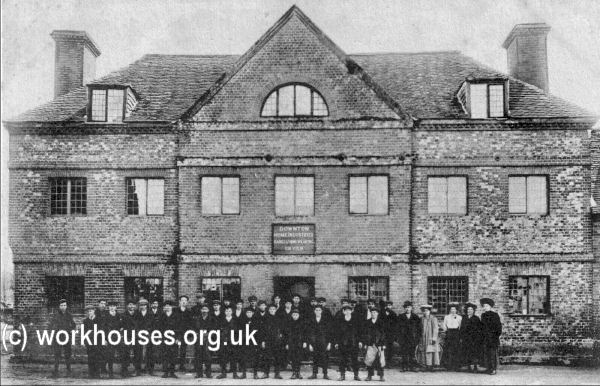
Former Downton parish workhouse, early 1900s.
© Peter Higginbotham.
After 1834
Alderbury Poor Law Union officially came into existence on 12th October 1835. Its operation was overseen by an elected Board of Guardians, 27 in number, representing its 22 constituent parishes as listed below (figures in brackets indicate numbers of Guardians if more than one):
County of Wiltshire:
Alderbury, Britford, Clarendon Park, Coombe Bissett, Downton (4), Fisherton Anger (2), East Grimstead, West Grimstead, West Harnham, Homington, Landford, Laverstoke [Laverstock] and Ford, Milford, Nunton and Bodenham, Odstock, Pitton and Farley,
Salisbury, Standlinch [Standlynch], Startford-under-the-Castle, Toney Stratford [Stratford Toney], White Parish [Whiteparish] (2), Winterslow.
Later Additions: West Dean (from 1883), Earldoms (from 1836), East Harnham (from 1896), Langley Wood (from 1836), Morgan's Vale and Woodfalls (from 1923), Redlynch (from 1896), New Sarum (from 1905), Old Sarum (from 1836). The former Salisbury Incorporation parishes of St Edmund, St Martin and St Thomas were also added in 1869.
The population falling within the Union at the 1831 census had been 13,227 with parishes ranging in size from Standlinch (population 31) to Downton (3,652). The average annual poor-rate expenditure for the period 1833-5 had been £10,672 or 16s.2d. per head of the population.
Alderbury Poor Law Union erected a workhouse on Coombe Road at Harnham to the south of Salisbury in 1836-7. It was designed by Edward Hunt who was also the architect of the Wilton Union workhouse. In 1836, the Poor Law Commissioners authorised an expenditure of £4,975 on the construction of the building which was to accommodate 280 inmates.
In 1866, the workhouse was visited by Poor Law Inspector Mr. W.H.T. Hawley. His report noted that:
Furniture.— Mattresses made of cocoa-nut fibre, and beds stuffed with chaff, are supplied to all the inmates. There is a washing trough in every ward.
Inmates.— The paupers are classified according to the order, and are divided into nine classes. The men wear coats, trousers, and waistcoats, of army cloth or fustian; the women, chambray and print cotton gowns, and all have the proper under clothing, stockings, &c. The men work at the pump, the will, gypsum pounding, and garden work. The women do the usual household work, and wash, and sew. The girls in the school are employed in needlework. The recreation for the boys is gymnastics, for the girls skipping ropes; and both schools walk out twice a Week, attended by the teacher.
Medical Attendance.— All medicines, except cod-liver oil and quinine, are supplied by the medical officer.
Nursing.— There is no paid nurse. The nursing is performed by the inmates, and I have heard no complaint of its insufficiency.
Chaplain.— There is a chaplain, who gives the services prescribed by the order. The inmates, who are not members of the Established Church, attend the workhouse chapel by their own wish, and ministers of their own persuasions visit them when they desire it.
School.— The children are entirely separated from the other inmates. Both schools are under the charge of a schoolmistress.
Generally.— The only deficiency in this workhouse is a separate sick ward for boys; and a paid nurse ought to be appointed.
The union expanded in 1869 when it absorbed the parishes that had previously formed part of the Salisbury Incorporation.
The Alderbury Union workhouse was rebuilt in 1877-9 to a design by GB Nicholls. It had single-storey entrance blocks at the roadside to the north which would have contained the porter's lodge, receiving wards and casual wards. The two-storey T-shaped main block behind had administrative offices at the centre, with separate male and female accommodation at each side, and kitchen ad dining-hall to the rear. An infirmary was erected to the west of the workhouse, and a further complex at the north-east which may have housed children. The site layout and location are shown on the 1881 map below:
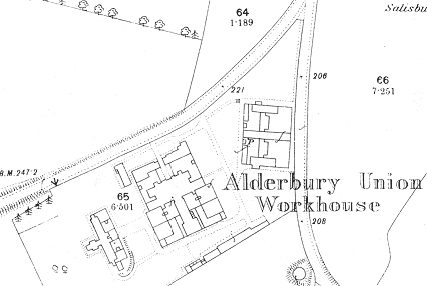
Alderbury workhouse site, 1881.
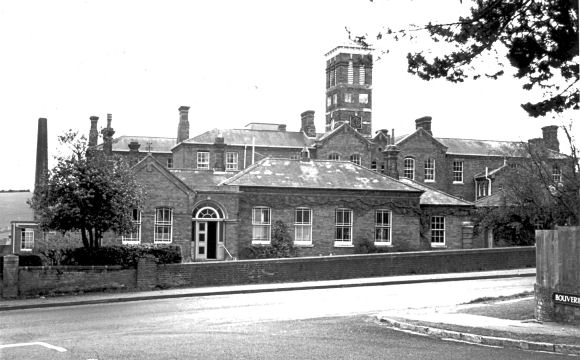
Alderbury union workhouse from the north, 1970s.
Courtesy of Peter Goodhugh.
By the end of the century, a chapel had been erected to the west of the main workhouse building.
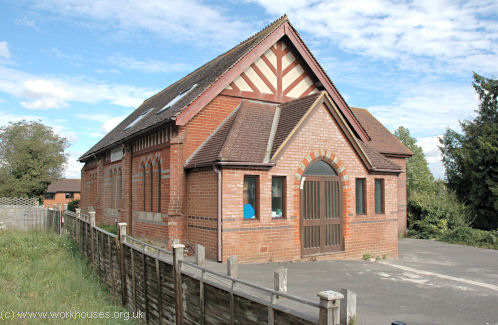
Alderbury workhouse chapel from the north-west, 2006.
© Peter Higginbotham.
By the 1920s, the workhouse became known as Tower House Poor Law Institution. After 1930, it became a Public Assistance Institution under the control of Wiltshire County Council. A new L-shaped block was erected at the west of the site, and another block at the north of the children's building.
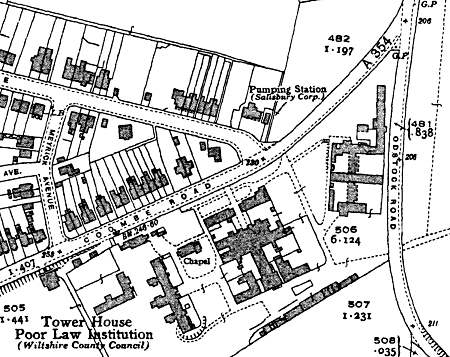
Alderbury workhouse site, mid-1930s.
By the 1970s, the site had been renamed Meyrick Close County Welfare Home. Virtually all the old buildings were demolished in the mid-1970s and housing estate now occupies much of the former workhouse site. The much altered chapel survives and is used by a local church.
Staff
Inmates
Records
Note: many repositories impose a closure period of up to 100 years for records identifying individuals. Before travelling a long distance, always check that the records you want to consult will be available.
- Wiltshire and Swindon Archives, Wiltshire and Swindon History Centre, Cocklebury Road, Chippenham SN15 3QN. Holdings include: Guardians' minutes (1835-1923, 1927-30); Admissions, discharges and deaths (from 19th century until 1925); Births (1914-40); etc.
Bibliography
- Higginbotham, Peter The Workhouse Encyclopedia (2014, The History Press)
Links
- None.
Unless otherwise indicated, this page () is copyright Peter Higginbotham. Contents may not be reproduced without permission.


